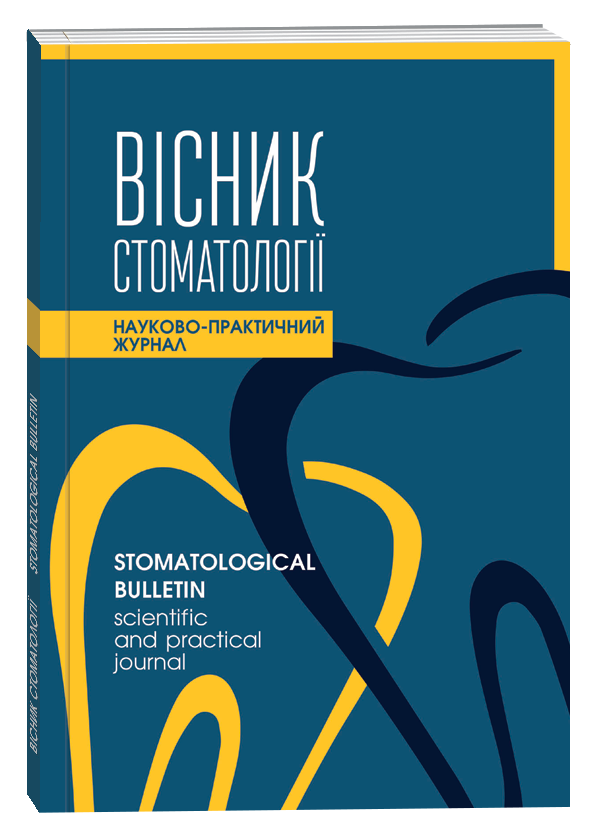BIOCHEMICAL AND MORPHOLOGICAL CHANGES IN THE ORAL FLUID OF PATIENTS WITH LICHEN PLANUS AFTER TREATMENT
DOI:
https://doi.org/10.35220/2078-8916-2023-47-1.15Keywords:
lichen planus, oral fluid, enzymes, white blood cells, epithelial cells, treatment.Abstract
The study of the pathogenesis of lichen planus in order to develop pathogenetic methods of treatment remains an urgent problem in dentistry in the future. Purpose of the study. To investigate biochemical and cytological changes in the oral fluid and oral mucosa in patients with lichen planus after our treatment. Materials and methods of research. The objects of the study were the oral mucosa and oral fluid of patients with lichen planus who underwent outpatient treatment at the state institution "Institute of Dentistry and maxillofacial surgery of the National Academy of Medical Sciences of Ukraine". After collecting an Anamnesis from patients and an objective clinical examination of the oral cavity, a diagnosis was made – erosive and ulcerative form of lichen planus. The paper presents the results of clinical, biochemical and morphological studies of oral fluid after treatment of patients with erosive and ulcerative form of lichen planus. It is shown that after the proposed treatment in the oral fluid of patients, an increase in the activity of lysozyme, a factor of non-specific antimicrobial protection, and a significant decrease in the activity of proteolytic enzymes are noted. In oral flushes, there is a decrease in the migration of white blood cells into the oral cavity, and a decrease in desquamation of the epithelium of the oral mucosa, which reflect the intensity of cell infiltration and inflammatory response. Research results and their discussion. Longterm observations show that after our treatment, the elements of the lesion epithelized on average 2 days faster in relation to the earlier treatment, and the number of relapses of the disease per year decreased in relation to treatment. Conclusions. The results of our clinical and laboratory studies indicate that the treatment we offer can be used in practical dentistry, and the course of treatment should be prescribed after each relapse of the disease.
References
Скиба В.Я., Скиба А.В., Почтарь В.Н., Македон А.Б., Рудинская Л.А. Современные взгляды на патогенез, лечение и профилактику рецидивов заболеваний слизистой оболочки полости рта. Дентальные технологии. 2012. № 1. 2(48–49). С. 10-12. 2. Данилевський М.Ф, Борисенко А.В. Захворювання слизової оболонки порожнини рота. Київ: Медицина, 2010. 639 с.
Етиологія, патогенез, клініка та лікування червоного плескатого лишаю слизової оболонки порожнини рота / Бараннік Н.Г. Методичні рекомендації. Київ, 2004. 24 с.
Колосова Е. Ю., Мельников О. Ф. Состояние локального иммунитета у больных красным плоским лишаем слизистой оболочки полости рта при наличии сахарного диабета II типа. Журнал вушних, носових і горлових хвороб. 2015. № 4. С. 78–83.
Антоненко М.Ю. Інтеграція неспецифічних чинників захисту організму в патогенезі червоного плоского лишаю слизової оболонки порожнини рота. Современная стоматология. 2017. № 5. С. 16-18.
Святенко Т.В. Иммуногистохимические исследования в диагностике различных форм красного плоского лишая. Запорожский медицинский журнал. 2006. № 2. С. 28-31.
Біловол А.М., Колганова Н.Л. Особливості порушень ліпідного обміну у хворих на червоний плоский лишай. Дерматологія та венерологія. Харківський національний медичний університет. 2019. № 3 (85). С13-15.
Мельник Т. В., Бондар С. А. Вплив комплексної терапії на показники маркерів оксидантного стресу у хворих на червоний плоский лишай. Український журнал дерматології, венерології, косметології. 2019. № 2 (73). С. 45-49.
Мельник Т. В., Бондар С. А. Супутня патологія як чинник загострення хронічних дерматозів, зокрема червоного плоского лишаю. Український журнал дерматології, венерології, косметології. 2017. № 4 (67). С. 88-89.
Левицкий А. П., Деньга О.В., Рябоконь Е.Н. Физиологическая микробная система полости рта в поддержании стоматологического здоровья детей. Науковий вісник Національного медичного університету ім. О. О. Богомольця. 2007. 28-29 вересня. С. 137-139.
Левицкий А.П. Казеинолитическая и БАЭЭ- эстеразная активность слюны и слюнных желез крыс в постнатальном онтогенезе. Бюллетень эксперрим. биологии и медицины.1973.Т.76,№ 8. С. 65-67.
Биохимические маркеры воспаления тканей ротовой полости: методические рекомендации / Левицкий А.П. и др. Одесса: КП ОМД, 2010. 16.
Скиба В.Я., Почтарь В.Н., Мечик И.Б. Уровень дифференцировки клеток эпителя в мазках–отпечатках со слизистой оболочки щеки у больных при лечении эликсиром «Эксодент–1». Вісник стоматології. 2004. № 1. С. 39-43.









